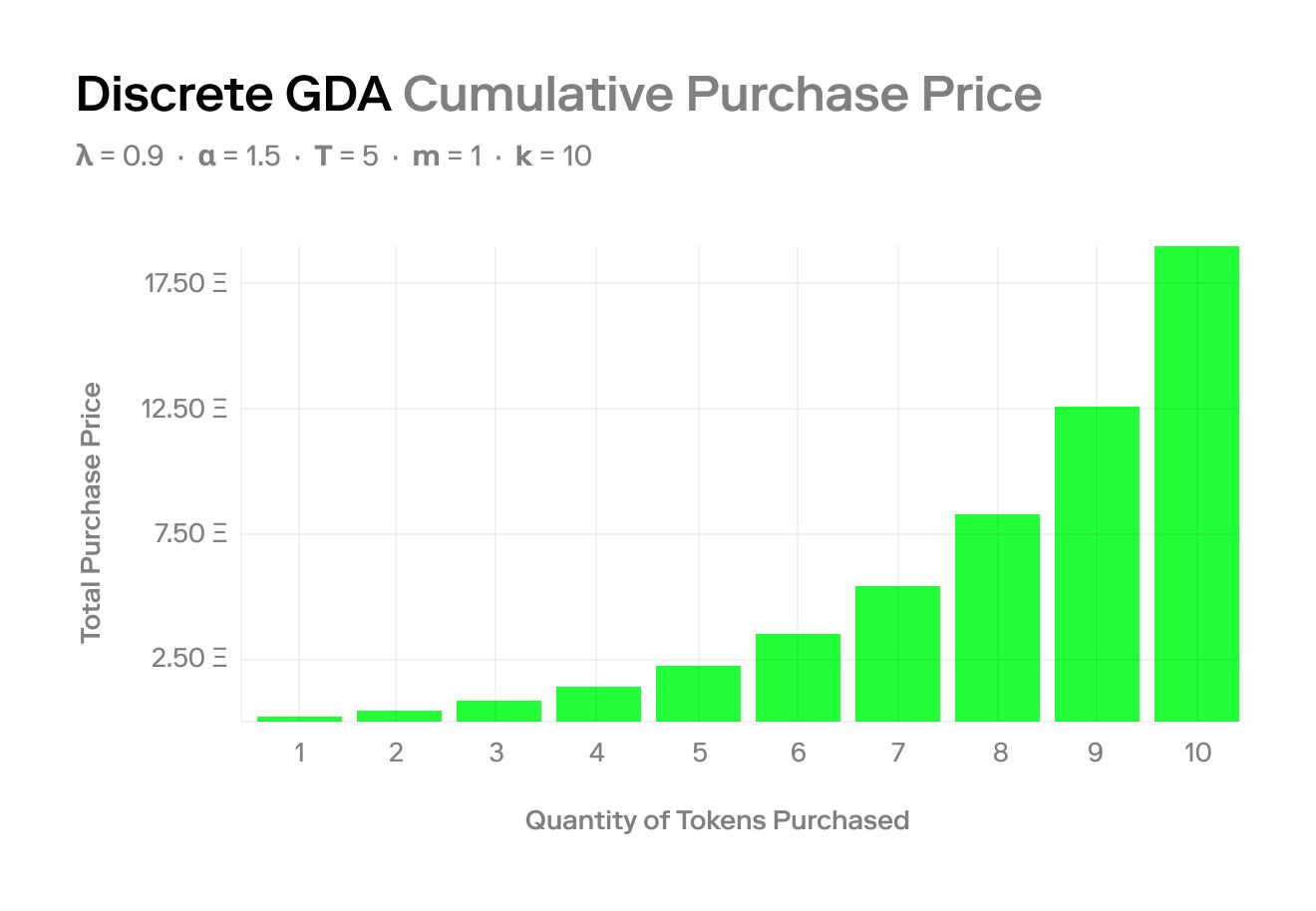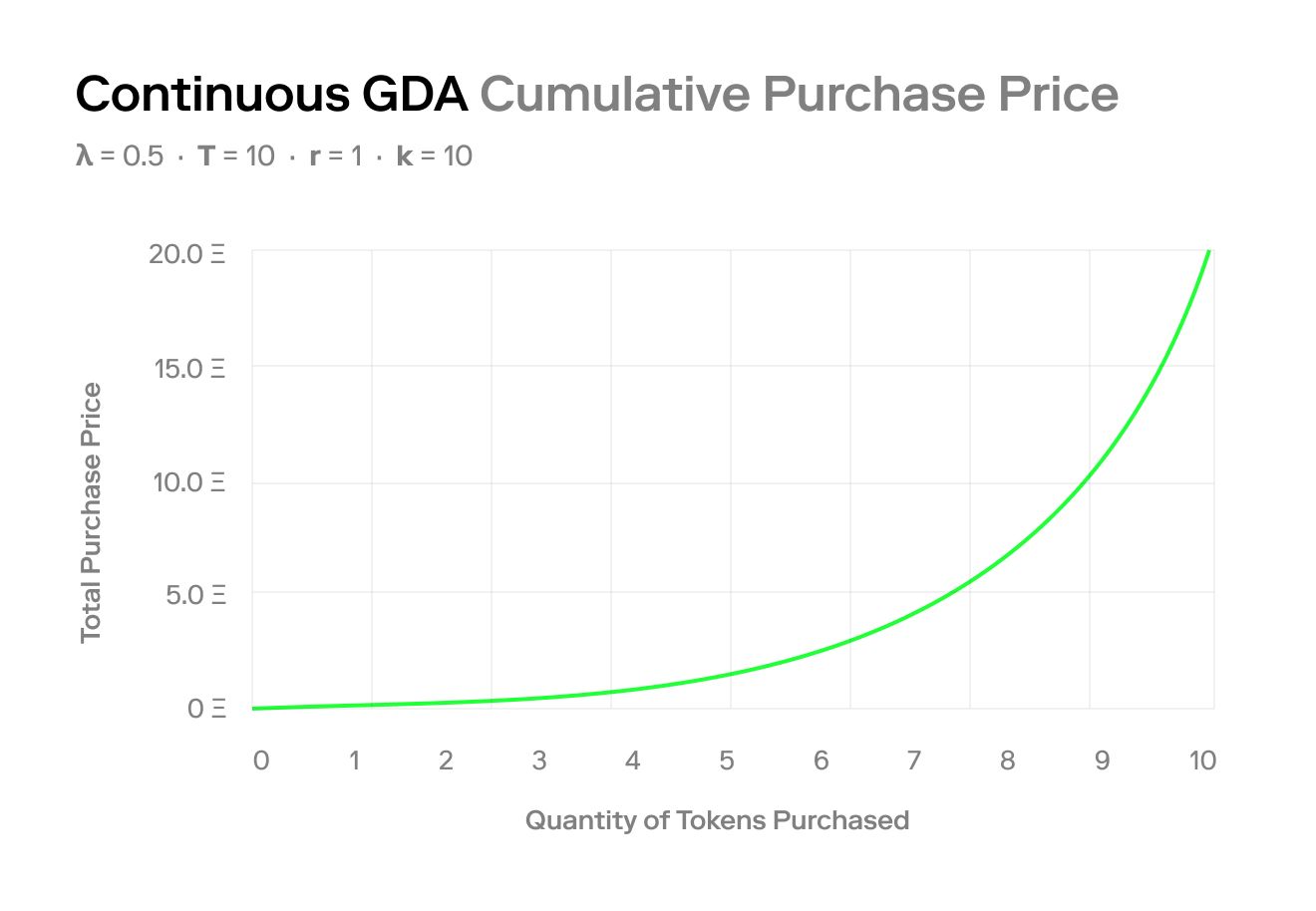Gradual Dutch Auctions
Apr 04, 2022 | Frankie, Dan Robinson, Dave White, andy8052
Contents
Introduction
This paper introduces the Gradual Dutch Auction, 1 or GDA, a mechanism that enables efficient sales of assets that do not have liquid markets.
GDAs solve a similar problem to TWAMM, but do not rely on the existence of liquidity providers willing to make markets on pairs of assets.
GDAs work by breaking up a sale into a sequence of Dutch auctions—a type of auction that start with a high asking price that is gradually lowered until a buyer makes a bid. GDAs allow you to purchase multiple of these auctions at once in a gas-efficient manner.
We provide an outline for both discrete GDAs, which are useful for selling NFTs, and continuous GDAs, which are useful for selling fungible tokens. We also include a Python notebook modeling the mechanism’s behavior, as well as a reference Solidity implementation.
Discrete GDA
Motivation
Imagine Alice would like to sell a collection of 10,000 NFTs. She is unsure what a fair price for her art pieces would be, so she does not want to sell them at a fixed price.
Instead, she might choose to sell them all in a single Dutch auction—starting with a high asking price, and gradually lowering it until all the NFTs are sold. However, such an auction can be suboptimal: there may not be enough interest from buyers to purchase all pieces at the same time.
Instead, Alice could auction off one NFT at a time. For example, she might start a new Dutch auction every minute for a new piece in her collection. This will give the market more time to find a fair price for her art.
Discrete GDAs are an extension of this idea, but support gas-efficient bulk purchases of multiple sub-auctions thanks to their mathematical properties.
Mechanism
Discrete GDAs are suitable for selling NFTs, because these have to be sold in integer quantities. They work by holding a virtual Dutch auction for each token being sold. These behave just like regular dutch auctions, with the ability for batches of auctions to be cleared efficiently.
In a discrete GDA, every auction starts at the same time, with each successive auction having a higher starting price. The price of each auction is given by some price function,
Various price functions can be used with GDAs. One particular well-behaved formulation is given by:
Here, the price for every auction decays exponentially according to some decay constant
Calculating Batch Purchase Prices
Given the above price function, we can efficiently compute the cost of purchasing a batch of auctions.
Imagine that Bob wanted to purchase some quantity
For the case of the above price function,
We can plot the quantity of tokens being purchased in a single order against their cumulative price to obtain the following figure:

Continuous GDA
Motivation
Having sold her NFTs, Alice now might want to sell some fungible tokens. One option would be for her to use the discrete GDA mechanism described above, to sell her tokens in fixed-sized lots.
However, Alice might not want to make all her tokens available for sale immediately, as is the case with discrete GDAs. For example, she might be running a protocol that sells emissions at some constant rate, say, 360 tokens per day.
Instead of using a discrete GDA, she could instead choose to sell her tokens in a series of standard dutch auctions. She could run one 360-token auction per day, one 15-token auctions per hour, or one 0.25-token auctions per minute. Again, there is a trade-off between price impact and gas efficiency, based on the number of auctions she holds.
Continuous GDAs work by taking this process to the limit, where the time interval between auctions approaches 0. This means that sales are split into an infinite sequence of auctions, each selling an infinitesimal amount of the token.
As it turns out, we can still compute the purchase price for any quantity of tokens in a gas-efficient manner.
Mechanism
Continuous GDAs work by incrementally making more of an asset available for sale, at a constant emission rate,
Emissions are broken up over an infinite series of virtual auctions. These auctions are started at an even rate over time, with each auction begining at the same price.
The price of each auction is given by some price function,
Like the previous example, price decays exponentially according to some decay constant
Calculating Purchase Prices
Say that Bob wanted to purchase some quantity
If the oldest available auction is
This means that we can compute the total purchase price in a gas-efficient manner as long as computing the integral of the price function is cheap.
The total price of purchasing
From which we obtain the following price curve:

Code
We’ve included a Python notebook modeling GDAs and a reference Solidity implementation.
Conclusion
GDAs are a useful mechanism for selling both fungible and non-fungible tokens that do not have liquid markets. While this paper derives a few useful price functions, we believe many more could be used in different contexts. We hope GDA will be useful in a variety of applications beyond those described in this paper.
If you’re a builder interested in implementing some of these concepts, please reach out to us at @FrankieIsLost, @danrobinson, @_Dave__White_ @andy8052 on Twitter. We’d be thrilled to hear from you.
Appendix
Derivation of Discrete GDA with Exponential Price Decay
Derivation of Continuous GDA with Exponential Price Decay
Footnotes
-
Also known as Australian Auctions. ↩
Acknowledgments: Achal Srinivasan, Andrew Kirillov, Matt Mizbani, t11s, 0xJepsen, 0xmons, cobie, Diego Ferrer, Grug, mewny, Zefram, Zubin Koticha
Graphics By: Achal Srinivasan
Disclaimer: This post is for general information purposes only. It does not constitute investment advice or a recommendation or solicitation to buy or sell any investment and should not be used in the evaluation of the merits of making any investment decision. It should not be relied upon for accounting, legal or tax advice or investment recommendations. This post reflects the current opinions of the authors and is not made on behalf of Paradigm or its affiliates and does not necessarily reflect the opinions of Paradigm, its affiliates or individuals associated with Paradigm. The opinions reflected herein are subject to change without being updated.